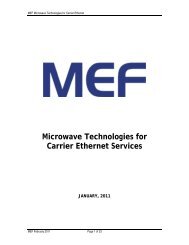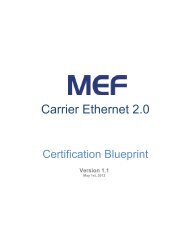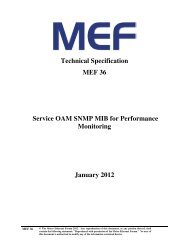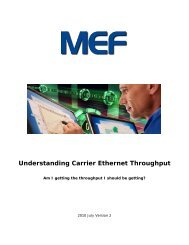Technical Specification MEF 16 Ethernet Local Management Interface
Technical Specification MEF 16 Ethernet Local Management Interface
Technical Specification MEF 16 Ethernet Local Management Interface
Create successful ePaper yourself
Turn your PDF publications into a flip-book with our unique Google optimized e-Paper software.
<strong>Ethernet</strong> <strong>Local</strong> <strong>Management</strong> <strong>Interface</strong> (E-LMI)<br />
number field of the Sequence Numbers information element. The UNI-C increments the<br />
send sequence counter using modulo 256. The value zero SHALL be skipped.<br />
3. When the UNI-N receives a STATUS ENQUIRY from the UNI-C, the UNI-N SHALL<br />
check the receive sequence number received from the UNI-C against its send sequence<br />
counter. If the values do not match, an error condition SHALL exist.<br />
The received send sequence number SHALL be stored in the receive sequence counter.<br />
The UNI-N then SHALL increment its send sequence counter and places its current value<br />
in the send sequence number field and the value of the receive sequence counter (the<br />
last received send sequence number) into the receive sequence number field of the outgoing<br />
Sequence Numbers information element. The UNI-N then SHALL transmit the<br />
completed STATUS message back to the UNI-C. The UNI-N SHALL increment the<br />
send sequence counter using modulo 256. The value zero SHALL be skipped.<br />
4. When the UNI-C receives a STATUS message from the UNI-N in response to a STA-<br />
TUS ENQUIRY, the UNI-C SHALL check the receive sequence number received from<br />
the UNI-N against its send sequence counter. If the values do not match, an error condition<br />
SHALL exist. The received send sequence number SHALL be stored in the receive<br />
sequence counter.<br />
NOTE – The value zero in the receive sequence number indicates that the receive sequence<br />
number field contents are undefined; this value is normally used after initialization. The value<br />
zero SHALL not be sent in the send sequence number field so that the receive sequence number<br />
SHALL never contain the value zero to differentiate the undefined condition from the normal<br />
modulo round off.<br />
Figure 27 shows an example of the use of the send and receive sequence numbers.<br />
<strong>MEF</strong> <strong>16</strong><br />
© The Metro <strong>Ethernet</strong> Forum 2006. Any reproduction of this document, or any portion thereof, shall contain the<br />
following statement: "Reproduced with permission of the Metro <strong>Ethernet</strong> Forum." No user of this document is<br />
authorized to modify any of the information contained herein.<br />
Page 21








